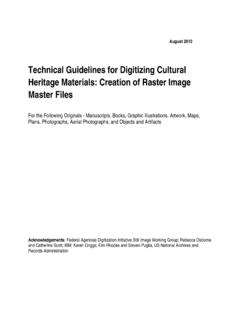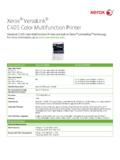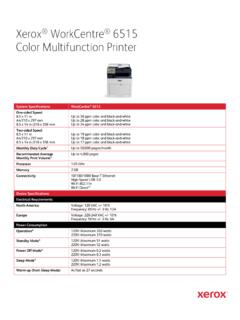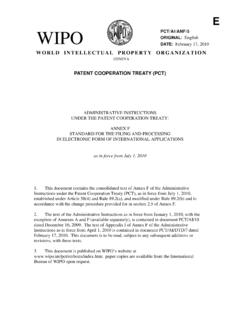Transcription of Guidelines for TIFF Metadata Recommended …
1 Guidelines for tiff Metadata Version Guidelines for tiff Metadata Recommended elements and format Version February 10, 2009 tagged image File format ( tiff ) is a tag-based file format for the storage and interchange of raster images. It serves as a wrapper for a variety of encoded bit-mapped images, and is a popular format to use as a sustainable master in cultural heritage digital imaging projects. Created in the mid-1980s, tiff was designed to be cross platform, backward compatible and, whenever possible, forward compatible. The most recent version of tiff is , published in 1992.
2 Adobe Systems controls the tiff specification. Metadata is an essential component of the tiff format ; many tiff images dating back to the 1980s still can be displayed in modern tiff readers through the interpretation of the tagged Metadata set. The tag set is extensible through a system of private tags and a framework for new complete systems of tags. Aware Systems tiff Tag Reference lists 36 Baseline tags, 60 Extension tags, 74 Private tags, plus a set of 58 Exchangeable image file format (Exif) tags standardized by the Japan Electronics and Information Technology Industries Association (JEITA), a large group of camera manufactures.
3 Other large extension sets of tags have been developed for GPS, GeoReference, and medical informatics purposes, as well as for Adobe s Digital Negative (DNG) specification. The Library of Congress also maintains a complete tag list, along with significant additional information on the sustainability of numerous digital file formats at While the tag system has been extremely successful, the proliferation of tags and tag sets complicates Metadata extraction; most tiff programs only locate and display the baseline, extension, and a few private tags. Only the Exif tag system is widely supported.
4 A second difficulty is that the extracted data is difficult to use and store because of the different data types for the various tagged fields, and the lack of any systematic data structures and formats. One response to these tiff Metadata issues has been the development and adoption of Adobe s Extensible Metadata Platform (XMP). XMP defines a standard way to express standardized tiff Metadata in RDF-based XML. Dublin Core and International Press Telecommunications (IPTC) description sets, the Exif technical set, and any other formally defined Metadata sets are also structured into RDF XML, and the entire Metadata package is embedded in a single tiff tagged field.
5 These tiff tag Guidelines , submitted by the Still image Working Group, present a minimal set of embedded Metadata for digital imaging of historical and cultural heritage materials. These Guidelines assume that all baseline tags required by the tiff Specifications are properly in place so that all images will be accepted by any tiff image validator. The first table, the Suggested Minimal tiff Tag Set, specifies those baseline tags considered particularly important to the cultural heritage community. Some, such as XResolution (Tag 282), may be inaccurately entered.
6 PhotometricInterpretation (Tag 262) is important for grayscale images which are not supported by the Exif standard. Also included on this list are those extension tags 2/10/2009 Online Version of this Document is Considered Official Page 1 Guidelines for tiff Metadata Version which present critical information, such as DocumentName (Tag 269), or which contain mandatory data, when applicable, such as ExtraSamples (Tag 338), needed to mark an alpha channel.
7 The tags included in the second table, Notes on Additional Recommended Metadata , are Recommended for cultural heritage or historical digitization projects, but may not be considered essential by all. These tags are drawn from the entire tiff tag set including the Exif, IPTC, and Dublin Core private tag sets. Examples include the Make (Tag 271), giving the scanner manufacturer; IPTC copyright information (contained in Tag 33723); and LightSource (Tag 37384), which is particularly important when a target is included within the image . While these fields are categorized as Recommended , their inclusion adds value to the workflow and lifecycle chains of the images.
8 These recommendations for tiff tags are presented as an interim guideline. A new Recommended guideline encompassing a richer Metadata set in a more flexible format , with wider file format support, is expected to be developed by the Embedded Metadata Sub-group. References Adobe Systems Incorporated, tiff Revision , Final June 3, 1992 < >. Adobe Systems Incorporated, XMP Specification, September 2005 < >. Dublin Core Metadata Initiative, Dublin Core Metadata Element Set, Version , January 14, 2008 < >. IPTC, IPTC NAA Information Interchange Model Version 4, Version No.
9 4, Rev. 1, July 1999 < >. JEITA CP-3451, Exchangeable image File format for Digital Still Cameras: Exif Version , April, 2002 < >. Library of Congress, Sustainability of Digital Formats Planning for Library of Congress Collections, Updated March 6, 2008 < > 2/10/2009 Online Version of this Document is Considered Official Page 2 Guidelines for tiff Metadata Version Suggested Minimal tiff Tag Set Metadata Set Tag or identifier Name Description Sample Values Note tiff tag.
10 Baseline 256 ImageWidth The number of pixels per row 3616 Typical scanner size 257 ImageLength The number of rows of pixels in the image 4418 Typical scanner size 258 BitsPerSample Number of bits per component 8 8 8 8 Grayscale 24-bit color 259 Compression Compression scheme used on image data 1 = Uncompressed 4 = CCITT Group 4 262 PhotometricInterpretation The color space of the image data. 0 = WhiteIsZero. 1 = BlackIsZero. 2 = RGB. Additional color spaces are possible: CMYK (5), YCbCr (6), CIE L*a*b* (8), and others. 277 SamplesPerPixel The number of components per pixel 1 3 Grayscale 24-bit RGB color 282 XResolution Horizontal pixel count per resolution unit (inches, centimeters) 2400000/10000 240 ppi: Rational data type - 240 pp(unit) is often displayed this way 283 YResolution Vertical pixel count per resolution unit (inches, centimeters) 629145600/2097152 300 ppi: see above 296 ResolutionUnit Unit of measurement for X and Y Resolution (inches, centimeters) 1 2 3 None: pixel is irregularly shaped Inches Centimeters 306 DateTime Date and Time image was scanned 2008.










